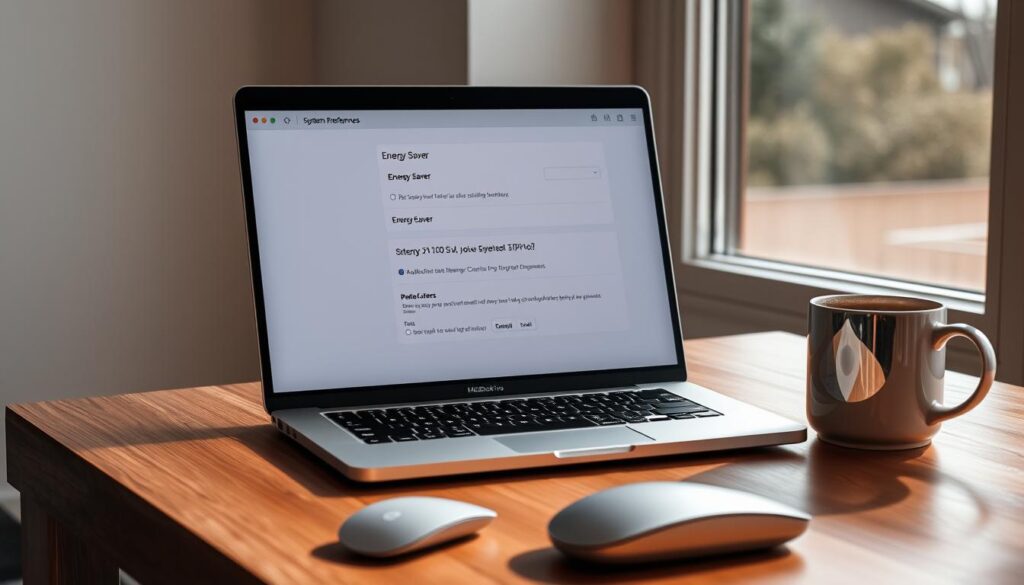Apple says 40% of MacBook users face battery drain during important tasks. This could be when you’re working on a big project or traveling. Learning how to make your MacBook’s battery last longer can really help.
This guide shows you how to make your MacBook’s battery last longer. You’ll learn about hidden settings and daily habits that help. Small changes, like adjusting the screen brightness or managing apps, can add hours to your battery life.
Find out how to keep your MacBook running well without losing its quality. It’s all about finding the right balance.
Key Takeaways
- Simple settings adjustments can boost battery life by up to 30%.
- Regularly checking battery health prevents sudden performance drops.
- Maximize macbook battery longevity with proper charging habits.
- Third-party apps help track and optimize energy use.
- Proper maintenance extends battery lifespan beyond Apple’s standard 1,000 cycle warranty.
Understanding Your MacBook Battery Health
Your MacBook’s battery is a powerhouse of energy, but it needs care. Learning how to monitor and maintain its health ensures you get the most from every charge. These macbook battery health tips start with understanding the basics.
How MacBook Batteries Work and Why They Degrade
Lithium-ion batteries in MacBooks gradually lose capacity over time. Here’s why:
- Charge cycles: Each full charge counts as one cycle, even if done in parts. After 1,000 cycles, capacity drops slightly—this is normal.
- Chemical aging: Heat and frequent full discharges speed up natural degradation.
Checking Your Current Battery Health Status
Find your battery’s condition in seconds:
- Go to About This Mac > System Report > Power for Apple’s built-in diagnostics.
- Use free apps like Coconut Battery for detailed reports.
Common Causes of Battery Drain
Battery killers include:
- Bright screens and plugged-in charging when not needed.
- Unused apps running in the background.
- Outdated macOS versions with efficiency flaws.
Setting Realistic Battery Life Expectations
“A well-maintained MacBook battery can last 3–5 years before noticeable decline.”
Compare your model’s specs to real-world usage. Older models may show lower capacity, but smart habits can help increase macbook battery lifespan. Regular checks and adjustments keep your device performing at its best.
How to Extend MacBook Battery Life Through Settings and Habits

Start by adjusting your system settings to optimize macbook battery performance. Go to System Preferences > Energy Saver. Turn on “Automatic Graphics Switching” to cut down on GPU use. Also, disable “Power Nap” to stop updates while sleeping.
For newer MacBooks, turn on “Optimized Battery Charging”. This slows down charging when it hits 80% and helps your battery last longer.
- Manage apps: Use Activity Monitor to find apps that use a lot of power. Close unused browser tabs—they use battery. Turn off background apps you don’t use often.
- Adjust display: Make your screen brightness lower than 50%. Turn off the keyboard backlight when you’re typing.
- Wi-Fi/Bluetooth: Turn off Wi-Fi and Bluetooth when you’re not using them. Using Airplane Mode saves battery in weak signal areas.
Make it a habit to unplug when your battery is at 80–85%. Keep your MacBook away from extreme temperatures. Store it between 62–72°F (16–22°C). Reset your System Management Controller (SMC) once a month to keep your battery working right.
“Avoid fully discharging the battery. Modern lithium-ion batteries last longer with partial charges.” — Apple Support
Using these macbook battery saving tricks together works best. Close apps you’re not using and dim your screen when you’re working for a long time. For intense work, plug in your charger. Small changes in settings and habits can make a big difference in your MacBook’s battery life.
Conclusion: Implementing These Tips for Long-Term Battery Performance
Small changes can greatly improve your MacBook’s battery life. Start by checking your settings. Turn on dark mode, lower the screen brightness, and close apps you don’t use. These actions cut down on energy use and help your battery last longer.
Also, remember to unplug your MacBook when it’s fully charged. Avoiding extreme temperatures is another key habit. By combining these habits, you can make a big difference in your battery’s health.
Focus on easy changes that make a big impact. Adjusting your display settings is quick but saves a lot of power. For more in-depth care, check your battery’s health and replace old cells when needed. Keeping your macOS up to date also helps manage power better.
These steps slow down battery wear and tear, which means you won’t need to replace it as often. This not only saves you money but also helps the environment by reducing electronic waste.
Start making these changes today, one or two at a time. Over time, these small actions will add up and make a big difference. Your MacBook will stay reliable and efficient for many years, saving you money and resources.




